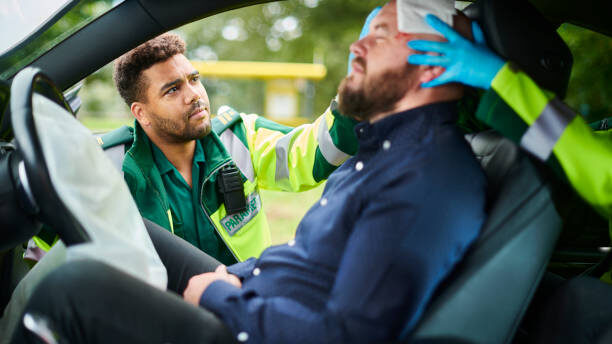Even a relatively insignificant fender bender can leave you rattled and result in minor injuries. Being involved in a major accident, such as a high-speed crash, could leave you with significant injuries, and some may not be apparent in the immediate aftermath of the accident.
For this reason, it’s always best to seek medical attention following an accident, whether you have visible injuries or not. Here are just a few of the most common injuries sustained in car accidents.
Bruises, cuts, and scrapes
During an auto accident, your body can be tossed around. Even though your seatbelt and other safety features like airbags and an active headrest help to minimize movement and reduce most common injuries like whiplash, you may still be jerked forward and back or side to side, possibly hitting hard surfaces in the vehicle.
In addition, glass and other parts of the car could break or be smashed in during the crash. All of these factors could lead to a variety of bruises, cuts, and scrapes, or even more significant gashes that require treatment like stitches following the accident.

Head trauma
Safety features in your car do a lot to minimize damage to your body during an accident, but they can only do so much. A frontal impact will definitely cause your airbag to inflate, protecting your head from hitting the steering wheel or dashboard, but this may not occur if you’re rear-ended or hit from the side, which are the most common types of accidents.
In such cases, your head may make contact with the steering wheel, dashboard, or side windows, depending on where you’re seated and where the car is hit. This could result in cuts, scrapes, serious lacerations, bruising, and of course, concussion or other brain injuries.
Broken bones
While not the most common injury seen in car accidents, broken bones certainly aren’t unheard of, and they can occur even in low-speed crashes. When legs or arms flail out during an impact, they could hit hard surfaces in the car, resulting in breaks. Broken ribs are not uncommon, especially for drivers, who may connect with the steering column during an accident.
Chest pain
Chest pain often occurs after a car accident due to life-saving measures like seat belts and airbags, especially in the most common types of accidents. A chiropractor can introduce recovery techniques that ease the tension in the area and ensure that alignment is unaffected.
Spinal cord injuries
The jolting movements that occur during a car accident can have harmful effects on spinal alignment. In many cases, victims won’t realize that their spine has been affected by a car accident until weeks or months later when the misalignment has led to an unrelated injury.
Seeking the care of a chiropractor immediately after a car accident can not only make you aware of any spinal injuries but also put you on the path to full spinal recovery sooner rather than later.
Herniated discs
A herniated disc, or slipped disc, is a type of spinal injury in which one of the discs of your spinal cord has been forcefully moved out of place. Regular chiropractic care is crucial to realign your spinal cord, and a licensed chiropractor can advise whether or not surgery is required.
Whiplash and soft tissue injuries
Whiplash and soft tissue injuries are two of the most common types of damage you can receive in a collision. When your car is moving, stops abruptly during a collision, and you are hit by a faster-moving vehicle, your body may be whipped back and forth.
This can cause soft tissues, like muscles, ligaments, and tendons, to stretch, strain, and even tear. This most commonly results in whiplash, which affects the neck and upper back. Although it may also cause incidental pain to the shoulders and the middle and lower back.
As well as whiplash, here are some of the other common types of soft tissue injuries:
- Contusions: Bruises formed from blunt force trauma to a muscle.
- Sprains: Tears in ligaments, typically caused by twisting motions and separated into categories of mild, moderate, or severe.
- Bursitis: Inflammation of fluid-filled sacs around joints.
- Tendonitis: Tendons connect our muscles to bones and inflamed tendons are known as tendonitis.
- Strains: Injuries sustained to muscles or tendons, often occurring in a person’s back, legs, or feet.
Treatment for soft tissue injury
Soft tissue injury sustained from a car accident can be very serious if left untreated. These types of injuries take a long time to heal and often develop scar tissue which brings another element of pain and discomfort. A skilled chiropractor can help speed up recovery by targeting the injury with a specialized treatment strategy.
Some soft tissue injuries may only need subtle manipulation and incremental movement to inspire healing, while others require full mobilization through a cast. After addressing the state of the injury, a chiropractor may choose to gradually increase your mobility with a passive motion that helps relax your muscles and pare down pain levels.
Migraines after a car accident
A migraine is another symptom that many people experience following a car accident. But because they can often begin days after the collision, the cause of the migraines isn’t always obvious.
A migraine feels like someone is pulling tightly on the inside of your head. Even the tiniest movement causes you incredible pain. A migraine often is accompanied by a sense of nausea and a sensitivity to light that’s so strong you have to lie down in a silent, dark room.
Experts aren’t yet sure what causes migraines, although it’s believed they’ve got something to do with the way in which your nerves communicate with each other. This can cause changes in blood flow in your head, resulting in migraines.
Tension headache
A tension headache feels like someone has placed your head in a vice grip and they’re gradually tightening it. This type of pain develops when the muscles in your neck and scalp pull against your head. It most commonly happens because the tendons and ligaments in your neck and head have been strained or sprained during the accident.
Causes of headaches and migraines
Painkillers only numb the nerves that are sending the pain signals to the brain. They don’t actually address the cause of the pain and fix it. Chiropractic treatment helps relieve your pain and discomfort by improving the alignment of your neck and spine.
If you’re experiencing a severe tension headache after a car accident, it could be caused by your scalp being pulled too tightly because your spine is no longer correctly aligned. When the vertebrae in your neck are misaligned, the tendons and ligaments are unable to function properly. This can cause them to pull on the muscles around your scalp, causing pain and tension.
Spinal misalignments can also have a negative effect on the way your nerves communicate with each other. When your nerves are unable to properly send signals to each other, you can experience headaches or migraines. Through chiropractic adjustments, your spine can be properly aligned and the motion to your joints can be restored, relieving your pain and discomfort.
Chiropractic benefits for auto injuries
Here are some of the reasons why you should always make an appointment with your chiropractor after you’ve been involved in a car accident:
- Neck and spinal adjustments restore motion to your joints and improve your body’s alignment. This relieves the pain caused by headaches and migraines.
- As chiropractic care is drug-free, there’s less chance of side effects or complications after treatment.
- Chiropractic adjustments can also release pinched nerves and relieve built-up tension, improving your flexibility and increasing your mobility.
- Adjustments and massage therapy can free up pressure that builds up in your back, which can also cause headaches, neck pain, and migraines.
- A chiropractor gets to the root of your pain and fixes the problem. They don’t just mask the pain with pills.
- A chiropractor can put together a custom treatment plan for you to follow at home to help you recover faster.
Chiropractic care doesn’t just focus on the spine. While spinal adjustments are one of the most important parts of this treatment, chiropractic care takes a holistic approach to treatment and looks at your body as a whole.

